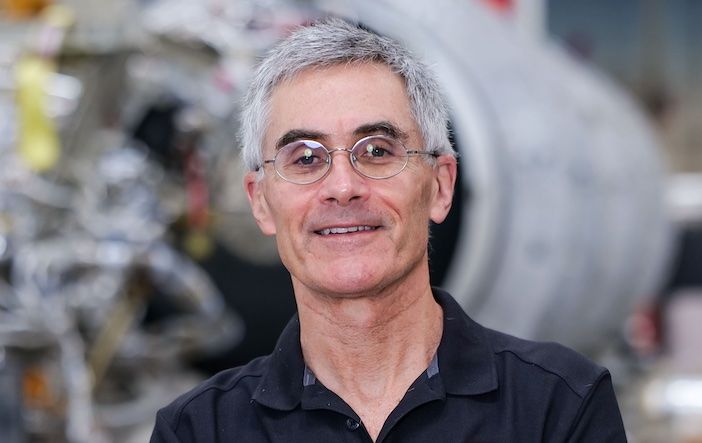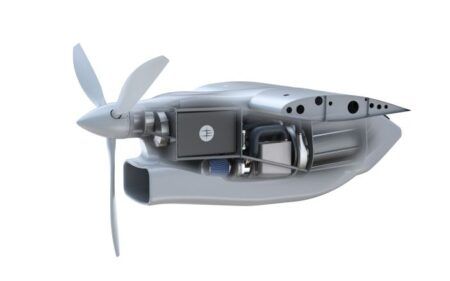The first in our new series of podcasts features John Garvey, chief engineer of launch for Virgin Orbit, discusses the company reaching space with its air-launched rocket and the challenges of testing and launching horizontally underneath an aircraft wing.
This interview was conducted shortly after California-based Virgin Orbit successfully reached space for the first time with its LauncherOne rocket in January 2020.
Garvey, who has a worked in launches since the 1980s, discusses how launch procedures and testing have to be modified for a horizontally-launched rocket and how Covid-19 has impacted the way the team works.
Below is an edited transcript of the podcast:
Q: What does your job involve?
A: My focus on launch operations means I have a lot to do with technical oversight. I also have to be able to jump in temporarily and help with any issues. When we are in a launch campaign, I am at Mojave on the ground for the launch, or on console, being a launch operator. That’s the fun stuff.
Q: How did it feel to reach space with LauncherOne?
A: There was a lot riding on the last mission, so when it went well the major reaction was relief. Excitement too, but mainly relief. At every launch I’ve ever been involved with there is always one or two engineers worried about something. The margins are tight in this business, you can’t take anything for granted.
Every time we made it through another milestone during the launch it was an achievement – through max Q, stage separation, second stage burn. Once the mission was done we got the gear back and did the data reviews and it’s back to work for the next flight. But now we know we have a rocket that works, which is great.
The first test launch was seized upon by many (in the media) as a failure – how did Virgin Orbit view it?
I joined Virgin Orbit in June 2020 shortly after the first launch. I would say this, if you define failure in terms of whether it reached orbit, then yes it failed. But we are in a development and test program. If your criteria is – did we mitigate things, did we learn a lot, did we prove certain important things, then it was a success. There was a tremendous amount of verification achieved in that flight by flying out to the drop point, dropping the rocket from the aircraft and starting it. That we could get that far with a liquid rocket system checked off a lot of boxes.
Q: What was learnt from the first test launch?
A: With the second campaign there are a lot of improvements. There was a lot of data from that start up transient and the failure investigation from the first launch that enabled the second flight. You can do all the ground testing you want, but sometimes you’ve got to go into the environment and find out what it’s like. Everything we learnt from the first launch helped make the second launch successful; it was a critical step.

Q: What was different about the second launch?
A: We improved a lot of operational stuff, like transporting the rocket. There are a lot of things to consider when transporting a rocket, you have to worry about vibration, the Department of Transport and permits. Once you have perfected the basics you can focus on the technology. Lessons from the first campaign enabled the team to focus on issues more effectively and efficiently. For instance, we went out and did a cryoshock on one of our test stands, and the number of variances and discrepancies was much smaller. You can identify and manage problems better. You know faster which component to replace when something goes wrong.
Q: What is challenging about this type of air-launch?
A: There are a lot of differences between a horizontal liquid rocket and a vertical one. The plumbing is different. You have to deal with anti-vortex siphons and snorkels and manage the propellant differently. You have to build that into your monitoring system and warning systems.
The aspect of launching from the aircraft is also challenging. Going transonic at the bottom of a wing next to large engines putting out high frequency vibrations is a stressful environment. This type of launch also affects the acceptance testing. Instead of 20 seconds you might have to do it for three hours because that is the time the rocket is on wing.
Once you understand the principals you can work to it, but it is different. The vibration test might take all day instead of an hour. Having the crew on the aircraft, including the launch engineers, also means you need to have a more distributed mission control architecture. If the comms drops out and you have problems, you need rules on how to operate in those situations. The two flights so far have helped validate and refine some launch parameters but it’s an ongoing process.
Q: What remains before there are routine commercial launches?
A: In my view we are already a commercial launch company – we had NASA on board the last launch. We are also a research and development company and we are going to continue evolving.
Having said that the focus of development has shifted on to process and technology improvements instead of proof-of-concept. From a cost and business perspective streamlining is really important. We are moving from proving it works, to working out how to do it better and give customers what they want. That also means innovating in the CONOPS. Initially it may be best to do the payload integration at Long Beach if the launch frequency is low. But if you are launching more somewhere else, you might want to do that elsewhere, without duplicating costs.
Q: Do you think launches will get cheaper?
A: I would use the term less expensive. Our challenge is to drive costs down and get repeatability up. Cosmic Girl is a fixed cost. If you don’t fly a lot, it’s a sunk cost. It was the same with Pegasus and it’s the same with any launch pad. If you only use it once a year you are not getting value from it. So, volume is important. But an air launch gives you flexibility from the capability to be mobile.
Some may say it’s easier to bring a small satellite to a launch site than take a rocket to a small satellite. But if there is a region where there is a high demand for launches and we can do it easily and less expensively from that region, it makes sense to go there.
Q: What factors are influencing the development program now?
A: Safety is always a consideration and how we integrate with and operate the aircraft is also the main aspect. Things like powering the aircraft up, putting the flight crew on it versus doing testing is different.
Covid-19 has also had a big impact. It has determined how many people we can have out at a launch and if the customer comes out. Positive tests can cause personnel issues. We haven’t been able to have an environment optimized for launches and testing. It’s an extra layer of challenge on top of what we already have. That we were able to still go out and do a successful launch in the Mojave Desert is a real testament to the team here.
Q: Has Covid-19 had any other impact on the program?
A: It’s really impacted how we work. A lot is done over telecon. We can’t all go into a room and use a whiteboard to solve problems. People miss the human dynamic and instant communications.
But being able to work from home enabled us to do the last launch. Remote working means you can be involved in a launch or a test from almost anywhere, whether at home or at the facility in Long Beach.
Q: Are there any advantages to remote working?
A: Looking forward, as we look to launch from multiple places, such as Cornwall in the UK, remote working may mean we don’t have to send dozens of people to the launch and set up a control room. We can be more efficient and set up people with the right skillsets on standby at other locations. It’s going to be a really interesting part of the operations moving forward to see how we can implement that.
Q: Would you recommend your job to a nephew or niece?
A: It’s a really exciting time to be in aerospace. There’s a lot of opportunity if you are a young engineer and you’re willing to put in the time. But every launch you see, it’s worth remembering there’s been a tremendous amount of work into making that happen. I’m an ops guy and you have to be prepared to put in the work – whether that’s at 12 ‘o’clock on Saturday night or 6am on Sunday morning you’ve got to be there if there is value in you being there. You need to know how you will fit into that lifestyle. I also tell them to pay attention to the market. Read magazines like ATI, and show you are aware and knowledgeable of the market.





